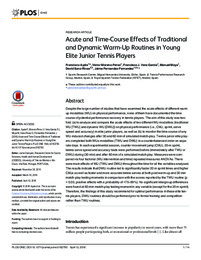Por favor, use este identificador para citar o enlazar este ítem:
https://hdl.handle.net/11000/30757Registro completo de metadatos
| Campo DC | Valor | Lengua/Idioma |
|---|---|---|
| dc.contributor.author | Ayala, Francisco | - |
| dc.contributor.author | Moreno Pérez, Víctor | - |
| dc.contributor.author | Vera-Garcia, Francisco J | - |
| dc.contributor.author | Moya, Manuel | - |
| dc.contributor.author | Sanz-Rivas, David | - |
| dc.contributor.author | Fernández-Fernandez, Jaime | - |
| dc.contributor.other | Departamentos de la UMH::Ciencias del Deporte | es_ES |
| dc.date.accessioned | 2024-01-26T11:29:31Z | - |
| dc.date.available | 2024-01-26T11:29:31Z | - |
| dc.date.created | 2016-04-12 | - |
| dc.identifier.citation | PLoS ONE 11(4): e0152790 | es_ES |
| dc.identifier.issn | 1932-6203 | - |
| dc.identifier.uri | https://hdl.handle.net/11000/30757 | - |
| dc.description.abstract | Despite the large number of studies that have examined the acute effects of different warm up modalities (WU) on physical performance, none of them have documented the time course of potential performance recovery in tennis players. The aim of this study was twofold: (a) to analyze and compare the acute effects of two different WU modalities (traditional WU [TWU] and dynamic WU [DWU]) on physical performance (i.e., CMJ, sprint, serve speed and accuracy) in elite junior players, as well as (b) to monitor the time course of any WU-induced changes after 30 and 60 min of simulated match-play. Twelve junior elite players completed both WUs modalities (TWU and DWU) in a counterbalanced order on separate days. In each experimental session, counter movement jump (CMJ), 20-m sprint, tennis serve speed and accuracy tests were performed before (immediately after TWU or DWU) during (30 min) and after 60 min of a simulated match play. Measures were compared via four factorial (WU intervention and time) repeated measures ANOVAs. There were main effects of WU (TWU and DWU) throughout the time for all the variables analysed. The results indicate that DWU routine led to significantly faster 20 m sprint times and higher CMJs as well as faster and more accurate tennis serves at both post warm-up and 30 min match-play testing moments in comparison with the scores reported by the TWU routine (p < 0.05; positive effects with a probability of >75–99%). No significant intergroup differences were found at 60-min match-play testing moment in any variable (except for the 20 m sprint). Therefore, the findings of this study recommend for optimal performance in these elite tennis players, DWU routines should be performed prior to formal training and competition rather than TWU routines. | es_ES |
| dc.format | application/pdf | es_ES |
| dc.format.extent | 14 | es_ES |
| dc.language.iso | eng | es_ES |
| dc.publisher | Public Library of Science | es_ES |
| dc.rights | info:eu-repo/semantics/openAccess | es_ES |
| dc.rights.uri | http://creativecommons.org/licenses/by-nc-nd/4.0/ | * |
| dc.title | Acute and Time-Course Effects of Traditional and Dynamic Warm-Up Routines in Young Elite Junior Tennis Players | es_ES |
| dc.type | info:eu-repo/semantics/article | es_ES |
| dc.relation.publisherversion | https://doi.org/10.1371/journal.pone.0152790 | es_ES |

Ver/Abrir:
Acute and Time-Course Effects of Traditional.pdf
698,54 kB
Adobe PDF
Compartir:
 La licencia se describe como: Atribución-NonComercial-NoDerivada 4.0 Internacional.
La licencia se describe como: Atribución-NonComercial-NoDerivada 4.0 Internacional.
.png)